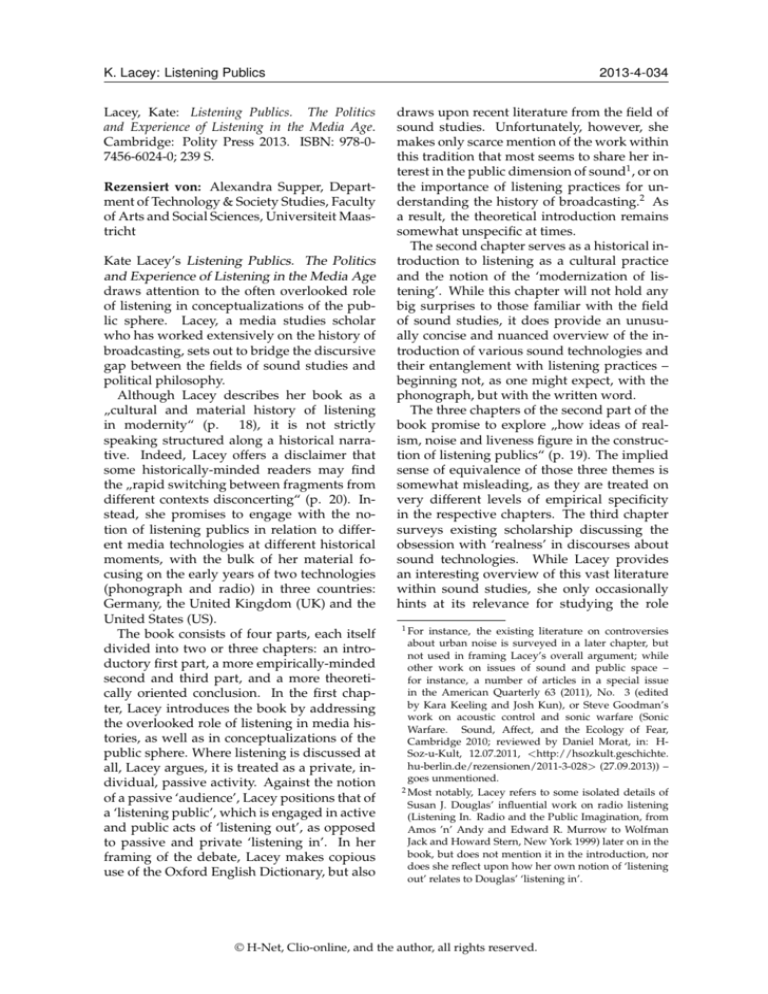
K. Lacey: Listening Publics
Lacey, Kate: Listening Publics. The Politics
and Experience of Listening in the Media Age.
Cambridge: Polity Press 2013. ISBN: 978-07456-6024-0; 239 S.
Rezensiert von: Alexandra Supper, Department of Technology & Society Studies, Faculty
of Arts and Social Sciences, Universiteit Maastricht
Kate Lacey’s Listening Publics. The Politics
and Experience of Listening in the Media Age
draws attention to the often overlooked role
of listening in conceptualizations of the public sphere. Lacey, a media studies scholar
who has worked extensively on the history of
broadcasting, sets out to bridge the discursive
gap between the fields of sound studies and
political philosophy.
Although Lacey describes her book as a
„cultural and material history of listening
in modernity“ (p.
18), it is not strictly
speaking structured along a historical narrative. Indeed, Lacey offers a disclaimer that
some historically-minded readers may find
the „rapid switching between fragments from
different contexts disconcerting“ (p. 20). Instead, she promises to engage with the notion of listening publics in relation to different media technologies at different historical
moments, with the bulk of her material focusing on the early years of two technologies
(phonograph and radio) in three countries:
Germany, the United Kingdom (UK) and the
United States (US).
The book consists of four parts, each itself
divided into two or three chapters: an introductory first part, a more empirically-minded
second and third part, and a more theoretically oriented conclusion. In the first chapter, Lacey introduces the book by addressing
the overlooked role of listening in media histories, as well as in conceptualizations of the
public sphere. Where listening is discussed at
all, Lacey argues, it is treated as a private, individual, passive activity. Against the notion
of a passive ‘audience’, Lacey positions that of
a ‘listening public’, which is engaged in active
and public acts of ‘listening out’, as opposed
to passive and private ‘listening in’. In her
framing of the debate, Lacey makes copious
use of the Oxford English Dictionary, but also
2013-4-034
draws upon recent literature from the field of
sound studies. Unfortunately, however, she
makes only scarce mention of the work within
this tradition that most seems to share her interest in the public dimension of sound1 , or on
the importance of listening practices for understanding the history of broadcasting.2 As
a result, the theoretical introduction remains
somewhat unspecific at times.
The second chapter serves as a historical introduction to listening as a cultural practice
and the notion of the ‘modernization of listening’. While this chapter will not hold any
big surprises to those familiar with the field
of sound studies, it does provide an unusually concise and nuanced overview of the introduction of various sound technologies and
their entanglement with listening practices –
beginning not, as one might expect, with the
phonograph, but with the written word.
The three chapters of the second part of the
book promise to explore „how ideas of realism, noise and liveness figure in the construction of listening publics“ (p. 19). The implied
sense of equivalence of those three themes is
somewhat misleading, as they are treated on
very different levels of empirical specificity
in the respective chapters. The third chapter
surveys existing scholarship discussing the
obsession with ‘realness’ in discourses about
sound technologies. While Lacey provides
an interesting overview of this vast literature
within sound studies, she only occasionally
hints at its relevance for studying the role
1 For
instance, the existing literature on controversies
about urban noise is surveyed in a later chapter, but
not used in framing Lacey’s overall argument; while
other work on issues of sound and public space –
for instance, a number of articles in a special issue
in the American Quarterly 63 (2011), No. 3 (edited
by Kara Keeling and Josh Kun), or Steve Goodman’s
work on acoustic control and sonic warfare (Sonic
Warfare. Sound, Affect, and the Ecology of Fear,
Cambridge 2010; reviewed by Daniel Morat, in: HSoz-u-Kult, 12.07.2011, <http://hsozkult.geschichte.
hu-berlin.de/rezensionen/2011-3-028> (27.09.2013)) –
goes unmentioned.
2 Most notably, Lacey refers to some isolated details of
Susan J. Douglas’ influential work on radio listening
(Listening In. Radio and the Public Imagination, from
Amos ’n’ Andy and Edward R. Murrow to Wolfman
Jack and Howard Stern, New York 1999) later on in the
book, but does not mention it in the introduction, nor
does she reflect upon how her own notion of ‘listening
out’ relates to Douglas’ ‘listening in’.
© H-Net, Clio-online, and the author, all rights reserved.
of listening in the public sphere. Chapter
four connects to the theme of the book more
clearly, as it convincingly shows how sound
and public space are entangled in discourses
about noise. Combining existing scholarship
on the noises of modern cities with original archival sources, the chapter captures the
paradoxical role of new sound media, which
„contributed to the cacophony while at the
same time promising radically new forms of
control for the listener“ (p. 72). The fifth chapter zooms in on one very specific moment in
the history of radio by attending to the negotiations of ‘radiogenic form’ during the formative years of radio. Lacey focuses her account
of these negotiations of what radio is (or could
be) on Germany, beginning with the experiments of „render[ing] the unrepresentable in
sound“ (p. 107) during the Weimar era, and
concluding with a chilling analysis of how radio found its ultimate ‘radiogenic’ form as a
propaganda instrument for the Nazis.
It is in the third part of the book, ‘Ways of
Listening’, that the two themes of the book –
sound technologies and public spheres – are
brought together most convincingly. Chapter six deals with the ‘privatization of the listening public’. While Lacey identifies a clear
trend in the history of 20th century media
technologies towards an increasing privatization and individualization of the listening
public, she also problematizes the distinction
between ‘public’ and ‘private’ as often quite
complex and paradoxical. Chapter seven,
then, highlights the exceptions to this historical trend of privatization. Drawing upon primary sources from the UK and Germany from
the 1920s and 1930s, Lacey shows that listening has by no means always been a private
and individual act, but could also take a public and collective form.
The final section, ‘Listening in the Public
Sphere’, turns away from the detailed media
history of the previous chapters and towards
questions of political philosophy. In the first
of its two chapters, Lacey argues why listening should be taken seriously in political theory, and offers explanations for why it has
nonetheless been mostly neglected – without
much reference, however, to the rich empirical material discussed in the rest of the book.
In the final chapter, Lacey relates the current
surge of interest within media studies in the
ethics of media production and reception to
a much earlier discourse about listening practices in the broadcasting world. In doing so,
this chapter is one of the few places in the
book in which the rich historical material and
the theoretical discourse about public spheres
and media are explicitly brought together.
Overall, then, the central promise of the
book, of bridging the gaps between the discourse of sound studies and political philosophy, is only partially realized – the two traditions co-exist within the book, but are only
occasionally brought together. The historical
sections do not explicitly engage with literature or conceptual notions from political philosophy, while the more theoretical ones only
sometimes refer back to the empirical analyses. Still, the building blocks are all here
in this book, and they reinforce the potential
benefit of bringing the discourses closer together. Despite the fact that some theoretical work remains to be done, Lacey’s book
provides a collection of thoughtful, interesting and finely nuanced analyses of listening
practices in the media age.
HistLit 2013-4-034 / Alexandra Supper über
Lacey, Kate: Listening Publics. The Politics and
Experience of Listening in the Media Age. Cambridge 2013, in: H-Soz-u-Kult 11.10.2013.
© H-Net, Clio-online, and the author, all rights reserved.






